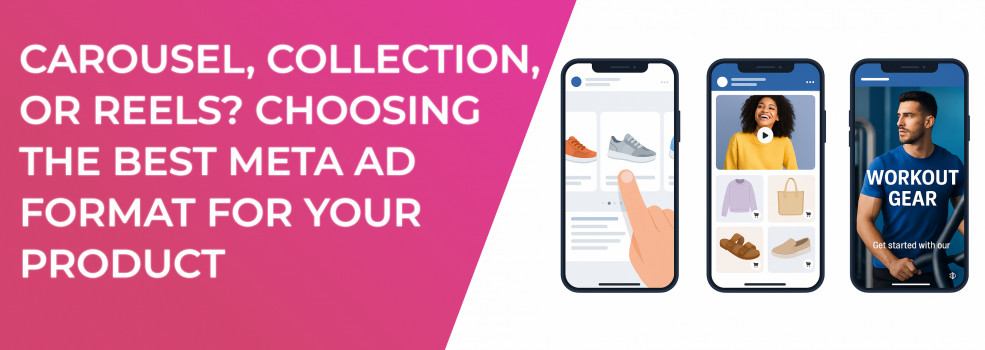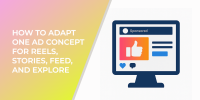Picking the perfect format is one of the quickest ways to improve Facebook ad performance. The moment you align creative style with campaign objective, you give Meta’s delivery system clearer signals, spend more efficiently, and create a smoother path from impression to conversion. In the next few minutes you will learn what each format does best, when to deploy it, and how to wring the most value from every click and view using proven Facebook ad optimization tactics.
Why Your Format Decision Shapes Results
Meta’s auction rewards relevance. If users swipe past a Carousel that should have been a Reels video, your average click-through rate drops, CPMs climb, and budget evaporates. Match format to user intent, and you can see a two- or even three-times lift in Facebook ads conversion rate without touching targeting or budget caps.
Carousel ads shine when you have a story to tell across multiple frames and want to lift the click-rate metric. Collection ads turn browsers into shoppers in one tap, often lowering Facebook advertisements cost by compressing the sales journey. Reels ride the algorithm’s appetite for short-form video and can add inexpensive reach to stagnant campaigns.
Before diving into specific tips for each format, remember that creative quality and data hygiene matter just as much as format choice. A poorly cropped image or a broken pixel will sabotage even the smartest placement strategy.
Deep Dive: Strengths and Watch-outs for Each Format
To help you weigh the pros and cons, read the overview first, then dig into the bullets for action steps.
1. Carousel Ads
Carousel units let you stitch together a narrative or show multiple SKUs side by side, perfect for product lines with variations in color or size.
Carousel ads let shoppers compare variations in a single swipe.
-
Strengths: Sequential storytelling, comparison shopping, fresh swipe engagement that keeps Facebook ad metrics like CTR healthy.
-
Watch-outs: Creative fatigue arrives quickly; shuffle card order every few days to avoid ad blindness. When performance starts to slide, check for early symptoms with this quick guide on spotting ad fatigue early and fixing it fast.
-
Optimization tip: Turn on Advantage Campaign Budget so Meta allocates more spend to the highest-performing cards and raises overall ROAS.
Treat the first card like a mini billboard. A strong cover image drives more swipes to the remaining frames and keeps users engaged.
2. Collection Ads
Collection ads pair a hero image or video with a product catalog so users can browse without leaving the feed.
Collection ads create a friction-free storefront right inside the feed.
-
Strengths: One-tap discovery lowers friction and improves Facebook advertisements cost because high interaction signals quality to the auction.
-
Watch-outs: A messy product feed or missing pixel events will stop delivery; audit your catalog before launch.
-
Optimization tip: Test variations in the cover media. Swapping a lifestyle hero for a plain product photo has lifted Facebook advertising analytics metrics by twenty percent in some campaigns.
Users expect a smooth path from ad to checkout. Keep product titles short and prices accurate to prevent feedback that inflates cost per impression.
3. Reels Ads
Reels are Meta’s fastest-growing placement, delivering a native, full-screen experience that feels organic and can revive campaigns stuck in the Facebook ads learning phase.
Reels ads capitalize on full-screen video to capture quick attention.
-
Strengths: Immersive viewing, low-cost reach, and strong discoverability when other placements stall.
-
Watch-outs: Vertical 9:16 only; captions must appear early, and hooks need to land in two seconds or less.
-
Optimization tip: Aim for at least fifty conversions or one thousand ThruPlays before judging performance. If you see “learning limited” in Ads Manager, broaden your audience or raise your bid cap. For more vertical-video best practices, see how to use Instagram Reels in your marketing strategy.
Short-form video rewards authenticity. Shoot native footage, keep edits quick, and use bold on-screen text so sound-off viewers stay engaged.
How to Match Format to Funnel Stage
Visualizing the funnel clarifies which placement belongs where. Picture your own funnel first—where are users bouncing? Then use the table as a quick reference.
A table can never capture every nuance, but it offers a useful starting point. Apply it, then refine based on your own metrics.
Measuring Success Without Guesswork
Metrics act as your compass. Start with CTR and impressions to gauge creative resonance. Add Facebook advertising cost per impression to understand auction pressure, then focus on CPA once Facebook Ads reporting leaves the learning phase. These diagnostics will also help you finish the Facebook learning phase quickly so results stabilize sooner.
Set up a simple Looker Studio dashboard tied to Meta’s API. Daily visualization prevents slow leaks in performance and highlights when a specific format is pulling the most weight.
Five Rapid-Fire Optimization Moves
Execution details separate average campaigns from record breakers. Try one tactic at a time, then note the lift.
-
Run a weekly pixel health check to prevent tracking gaps that skew Facebook advertising optimization decisions.
-
Test Advantage Campaign Budget against traditional CBO; many campaigns see ten percent greater efficiency.
-
Rotate fresh creative every seven days to keep good CTR on Facebook ads above benchmark.
-
Segment retargeting windows into seven-day and thirty-day pools so spend follows purchase intent.
-
Consolidate ad sets so each gathers enough volume to leave the learning phase quickly.
After one full cycle of tests, check whether your conversion ads on Facebook show a stable CPA. If they do, scale slowly — five to ten percent budget bumps per day. When you’re ready to push spend, follow this playbook on scaling Facebook ads without killing performance.
You’ve learned why format matters, how each option works, and the specific steps that push campaigns from mediocre to memorable. Apply what you read today, and let the data guide you toward the perfect blend of Carousel, Collection, and Reels for your product mix.

